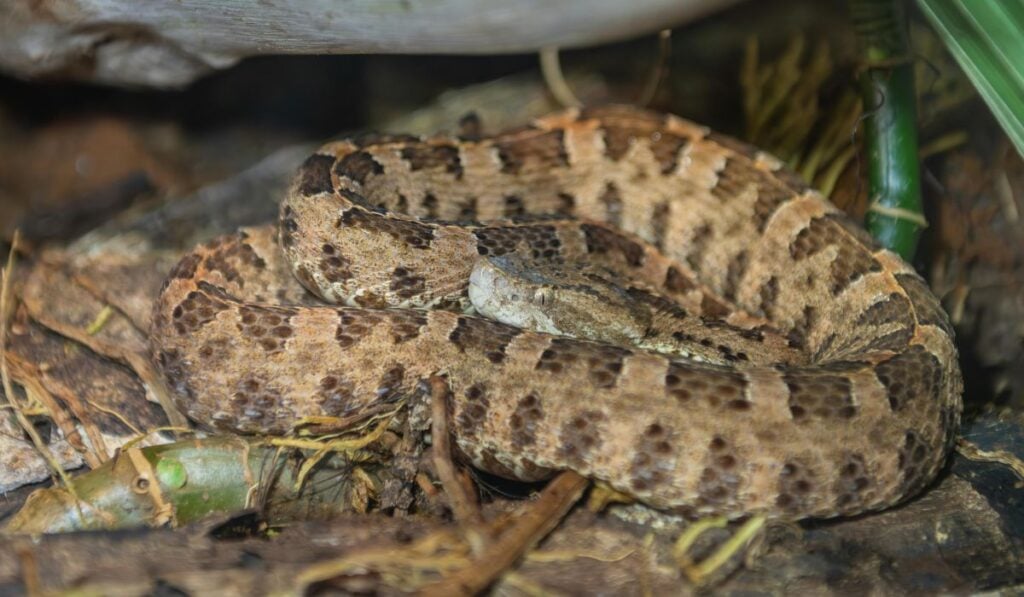Disclaimer: This article may contain affiliate links. Clicking on them may earn Costa Rica Vibes a commission, at no extra cost to you. Thank you for your support!
Costa Rica Snakes: How to Stay Safe & Where to See Them
Are you wondering what type of snakes Costa Rica is home to?
Costa Rica is a paradise of biodiversity and is home to an incredible variety of wildlife, including over 130 species of snakes.
I get it, the thought of encountering a snake can be daunting. I’ve been living in Costa Rica since 2016 and my number one wildlife fear is still snakes. They really freak me out. However, they are also an interesting part of the ecosystem here.
I created this guide to fill you in on the snakes you might encounter in Costa Rica, give you helpful info on staying safe, and let you know the places where you can see snakes in a secure environment.

Overview of Snakes in Costa Rica
Costa Rica is home to an incredible diversity of wildlife, and that includes snakes. The country is home to around 139 species. This means it has one of the highest snake diversities per square mile in the world!
The good news? Only 22 species are venomous. Most snakes in Costa Rica pose no threat to humans.
In fact, many non-venomous snakes play an essential role in controlling pest populations and even hunting venomous snakes.
Venomous Snakes to Watch Out For
While most of Costa Rica’s snakes are harmless, a few species could definitely harm you.
Knowing how to identify these snakes, understanding where they are likely to be found, and knowing what to do if bit, can significantly reduce your risk of a dangerous encounter.
Fer-de-Lance (Bothrops asper)

For me, the Fer-de-Lance is the snake I’m most scared of in Costa Rica. We have seen them a few times, always in national parks. We saw a dead one in Manuel Antonio National Park and we’ve seen a few in Cahuita National Park.
I’ve been paranoid about these ever since I read about Steve Rankin, one of the producers from the TV show Naked and Afraid getting bit by a fer de lance in Costa Rica and almost losing his foot. Definitely, look this up at your own risk, but the pictures are pretty insane.
He luckily was able to get airlifted to the hospital and receive medical treatment in San Jose pretty quickly. It was still a very long recovery process which involved 5 surgeries.
🐍 Where You Might See It:
- Caribbean lowlands: These are especially common in Tortuguero, Cahuita, and around Puerto Viejo.
- Pacific slope: Found in areas like Manuel Antonio and Corcovado.
- Agricultural areas: These snakes often hide near banana and palm plantations. I have heard of a lot of produce pickers getting bitten.
- Near rivers and streams: Frequently found resting near water sources.
🐍 How to Recognize It:
- Brown or olive with dark triangular patterns.
- Wide, flat head and a thick body.
- Juveniles have yellow-tipped tails.
⚠️ Important Info:
- Highly venomous, aggressive, and can jump up to 6 feet to strike. 😭
- Its venom is hemotoxic, causing severe tissue damage and internal bleeding.
- This snake is nocturnal, so be extra cautious on night walks.
- The fer-de-lance is responsible for most snakebite incidents in Costa Rica.
🚶♂️ Travel Tip: If you get bit by a fer-de-lance, I suggest you insist on being airlifted to CIMA hospital in San Jose.
Bushmaster (Lachesis Stenophrys)

The Bushmaster is the largest venomous snake in the Americas. It is rare, but it’s still one to be aware of if you’re exploring remote rainforest areas.
🐍 Where You Might See It:
- Dense rainforests of the Osa Peninsula (Corcovado National Park is a hot spot).
- Caribbean lowlands, including Tortuguero and La Selva Biological Station.
- Deep in primary rainforests, not often seen near human settlements.
🐍 How to Recognize It:
- Reddish-brown with dark diamond-shaped patterns.
- It can grow up to 10 feet long (yes, you read that right).
⚠️ Important Info:
- Rarely seen, but if startled, it may strike multiple times.
- Venom is both hemotoxic and neurotoxic, meaning it can cause paralysis.
- Unlike other pit vipers, Bushmasters don’t rattle or warn before striking.
Coral Snake

Small but dangerous, the Coral Snake is highly venomous. Thankfully, it’s shy and typically avoids humans. I have personally never seen one in Costa Rica.
🐍 Where You Might See It:
- Forested areas, grasslands, and even near homes in northern and central Costa Rica.
- Common in Monteverde, Arenal, and Sarapiquí.
🐍 How to Recognize It:
- Red, yellow, and black bands.
- Use the rhyme:
“Red touches yellow, kills a fellow; red touches black, venom lacks.”
⚠️ Important Info:
- The neurotoxic venom can cause respiratory failure if untreated.
- Not aggressive, but bites can be deadly if medical treatment is delayed.
Central American Rattlesnake (Crotalus Simus)

Rattlesnakes are well-known for their distinctive warning rattle, and the Central American variety is no exception. This is another snake I have yet to see in the country, thankfully.
🐍 Where You Might See It:
- Dry forests and scrublands of Guanacaste and the Nicoya Peninsula.
- Common in Santa Rosa National Park (near the Nicaragua border) and Palo Verde National Park.
🐍 How to Recognize It:
- Brown body with diamond-shaped markings.
- Distinct rattle at the end of its tail.
⚠️ Important Info:
- Venom is cytotoxic, causing severe pain, swelling, and tissue damage.
- If you hear the rattle, back away slowly!
Eyelash Pit Viper (Bothriechis schlegelii)

This small but striking snake is known for its vibrant colors and unique eyelash-like scales above its eyes.
We have seen this snake a few times, always in Cahuita National Park.
🐍 Where You Might See It:
- Rainforests on the Caribbean coast (Cahuita, Tortuguero).
- Sometimes it is found coiled on low branches in Monteverde and La Fortuna.
🐍 How to Recognize It:
- Bright yellow, green, or reddish-brown.
- Small, slender, with rough, keeled scales.
⚠️ Important Info:
- Arboreal (lives in trees). Watch where you put your hands when hiking. Don’t grab onto treees because these guys might be there.
- Not considered aggressive, but its bite causes swelling and tissue damage.
Neotropical Rattlesnake (Crotalus simus)

A close relative of the North American rattlesnake, this species prefers dry forest regions.
🐍 Where You Might See It:
- Dry forests of Guanacaste and Nicoya Peninsula.
- National parks such as Santa Rosa, Palo Verde, and Barra Honda.
- Occasionally near farmland and open fields.
🐍 How to Recognize It:
- Distinct rattle at the end of its tail.
- Brown body with dark diamond-shaped markings.
⚠️ Important Info:
- Venom is particularly dangerous because it affects the nervous system and can cause muscle paralysis.
- If you hear a rattle, back away slowly. This is the snake’s warning before striking.
- More common in the dry season when it’s actively hunting for prey.
Non-Venomous Snakes
Costa Rica is also home to many non-venomous snakes that play crucial roles in the ecosystem.
These snakes help control populations of rodents and other small animals.
Boa Constrictor (Boa constrictor)

One of the largest and most famous non-venomous snakes in Costa Rica is the Boa Constrictor. This snake is considered a master of ambush hunting.
🐍 Where You Might See It:
- Rainforests and dry forests, including Corcovado, Manuel Antonio, Monteverde, and Arenal.
- Farms and rural areas: especially near livestock, since boas control rat populations.
- Often found resting in trees or coiled up near trails.
🐍 How to Recognize It:
- Large, heavy-bodied snake (can grow up to 10 feet long!).
- Dark brown saddle-shaped markings on a lighter background.
- Triangular head with distinctive heat-sensing pits.
✅ Interesting Facts:
- Kills by constriction: squeezes prey until their circulation stops.
- Eats rodents, birds, and even small monkeys.
- Despite their size, boas are docile and rarely aggressive unless provoked.
Green Vine Snake (Oxybelis fulgidus)

A slender, elegant snake with a super long snout, often mistaken for the Parrot Snake.
🐍 Where You Might See It:
- Tropical forests in Tortuguero, Cahuita, and Manuel Antonio.
- Common in gardens and near homes with dense vegetation.
🐍 How to Recognize It:
- Thin, green, and whip-like.
- Extremely long, pointed snout.
- Moves very slowly unless startled.
✅ Interesting Facts:
- Mildly venomous, but harmless to humans.
- Uses its long, flexible body to strike at frogs and lizards from a distance.
- If threatened, it opens its mouth wide, revealing a black interior to scare predators.
Cat-Eyed Snake (Leptodeira septentrionalis)

A nocturnal snake with big cat-like eyes, often found near rivers and ponds.
🐍 Where You Might See It:
- Near water sources in Tortuguero, Arenal, and the Osa Peninsula.
- Often seen near outdoor lights, where it hunts small prey.
🐍 How to Recognize It:
- Slender brown body with dark blotches.
- Large, golden eyes with vertical pupils.
✅ Interesting Facts:
- Mildly venomous, but harmless to humans.
- Often seen hunting frogs, lizards, and insects at night.
Mussurana (Clelia clelia)
The Mussurana is a natural predator of venomous snakes, especially Fer-de-Lances! Yes, this is the hero we never we needed.
🐍 Where You Might See It:
- Forests, farmlands, and rural areas.
- Often found near homes and plantations.
🐍 How to Recognize It:
- Juveniles are bright red, while adults are dark blue-black.
- Long and smooth-bodied, reaching up to 7 feet.
✅ Interesting Facts:
- Immune to venom from pit vipers (Fer-de-Lance, Bushmaster, etc.).
- Hunts dangerous snakes, rodents, and small mammals.
- If you see one, consider it a good sign. It is protecting you from venomous snakes!
Safety Precautions
By following a few simple precautions, you can significantly reduce the likelihood of a dangerous encounter and hopefully enjoy your adventures in Costa Rica without any incidents.
General Safety Tips:
- Wear Closed-Toe Shoes: If hiking, avoid sandals and opt for sturdy boots that a snake wouldn’t be able to bite through.
- Stick to Trails: Don’t wander into dense vegetation where snakes might hide.
- Use a Flashlight at Night: Many venomous snakes are nocturnal and are more likely to attack if disturbed at night.
- Watch Where You Step & Reach: Don’t put your hands into holes, under rocks, or on trees for support. I know, it is easier said than done. It’s so easy to use a tree for support while hiking. Really try to avoid it if possible.
- Be Aware Near Water: Some snakes, like the Fer-de-Lance, are often found near streams and rivers.
- Always Hike with a Buddy: Have somebody with you who can take control of the situation if you are bitten by a snake.
- Always Have a Charged Cell Phone: This is important so you can call 9-1-1 for help if needed
What to Do if Bitten:
A snakebite can be a terrifying experience. Here’s what you need to do:
- 🚑 Stay Calm: Panicking can increase venom spread. If I were bitten, I’d freak out and for sure not be calm, but the experts insist that staying as calm as possible slows the venom’s movement through your system.
- 🚑 Seek Medical Help Immediately: Costa Rica has excellent snakebite treatment facilities. Call 9-1-1 if needed. Even if you don’t have cell service, 911 should still work in most places.
- 🚑 Do NOT Use a Tourniquet or Ice: Despite what you may have heard, cutting off circulation or applying ice can make the situation worse. Tourniquets can cause tissue damage, and ice won’t help slow the venom’s effects.
- 🚑 Limit Movement & Keep the Bite Below Heart Level: Moving around can spread the venom faster. Try to stay as still as possible and keep the affected limb lower than your heart.
- 🚑 Remove Tight Clothing or Jewelry: If bitten on the hand or foot, swelling can happen fast. Take off rings, watches, or anything that could cut off circulation.
- 🚑 Get to a Hospital ASAP: Costa Rica’s hospitals and some doctor’s offices have antivenom, but snakebites are time-sensitive. The faster you get treatment, the better your outcome.
- 🚑 If Possible, Identify the Snake: Without getting too close, try to note the snake’s color, shape, and any markings. This helps medical professionals administer the correct antivenom.
If things are very bad and you need to be transferred to a hospital, I suggest always asking to be taken to CIMA hospital in San Jose if possible. This may require being airlifted.
CIMA is the best hospital in the country with top-notch facilities. It is where I would feel most confident to get the necessary treatment.
Where to See Snakes Safely
If you are interested in observing snakes without the risk of a wild encounter, there are a few good options.
Widlife Rescue Centers
There are several amazing wildlife rescue centers throughout the country that work to rehabilitate injured wildlife to be re-released into the wild (if possible) or to be kept in a safe and comfortable environment if release is not possible.
These rescue centers are home to a wide variety of animals including sloths, monkeys, birds, and of course snakes!
To find the perfect place, check out our guide to the best Costa Rica animal sanctuaries.
Guided Tours
A guided tour through a national park or private reserve is another great way to see animals such as snakes with somebody who knows how to spot them and also knows the precautions that you should take.
We have found that some of the best snake sighting experiences we have had have been on wildlife night tours. These are walks with an experienced guide in the dark. You are typically given a headlamp to use and your guide will show you a variety of animals during your walk.
Here are some great wildlife night tours throughout the country
Of course, this is not completely without risk. You could definitely still get bitten while on a wildlife tour. However, having a guide also means you have someone with you who can take charge to make sure you get the proper medical care needed.
Conclusion
We get it, snakes can be scary. However, we have lived in this country since 2016 and have never been bitten, so I can assure you the chances of you being bitten during your vacation are probably very low.
If you have any questions about protecting yourself from snakes, don’t hesitate to leave them in the comment section below. We are always happy to help you plan!
You Might Also Enjoy:


Costa Rica Travel Details: What You Need to Know
🚗 Should I rent a car in Costa Rica?
Having a rental car will give you the most flexibility when traveling in Costa Rica. This will also allow you to take fun day trips on your own.
- Save 10% Plus Other Perks with Our Adobe Rental Car Discount
- You might also consider; shared shuttle services or private transfer services
🏄🏽 How can I book things to do?
We find that Viator tends to have the most comprehensive selection of activities with secure booking and good cancellation policies.
🍍 I’m overwhelmed with planning. Can you help?
Of course! I suggest joining our Facebook group for specific questions and head to our Start Here Page to get started planning.
✈️ What is the best way to book a flight?
Usually, we have the best luck finding great prices with Skyscanner. Check for flights to both San Jose Airport (SJO) and Liberia Airport (LIR).
🛏️ What is the best way to book my Costa Rica hotels?
We highly suggest Booking.com for hotel bookings and typically use VRBO for Costa Rica vacation rentals.
🗣️What is the main language in Costa Rica?
The main language in Costa Rica is Spanish. Most people working in tourism speak at least some English.
💰 What is the currency in Costa Rica?
The currency used in Costa Rica is the Costa Rican colón (CRC). However, the US dollar is widely accepted in most tourist areas
📞 What is the best way to stay connected?
An eSIM from Airalo is the easiest way to get 4G data while traveling in Costa Rica.
🌴 Is Costa Rica safe?
Generally, Costa Rica is considered safe for tourists. However, like any travel destination, it’s best to use caution and be aware of your surroundings.
🛂 Do you need a passport to go to Costa Rica?
Yes, Costa Rica is its own country. You will need a passport to visit.

Hi! We’re Thomas (the German) and Sarah (the US-er)
We met in Virginia, moved to Germany, and since 2016 we have lived in sunny Costa Rica.
It was a spontaneous decision to move here, but it was the best decision!
Now we spend our days roaming the country to bring you the very best in Costa Rica travel here on Costa Rica Vibes.
Sarah is the writer. Thomas is the one keeping it all together.
Want the whole crazy story?

Sarah McArthur
Sarah McArthur is the co-founder and main writer of Costa Rica Vibes.
She is originally from the United States but has lived in sunny San Jose, Costa Rica since 2016.
She has traveled all over the country and now considers herself a self-proclaimed Costa Rica travel expert.
Want the whole crazy story?

